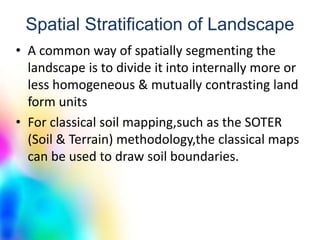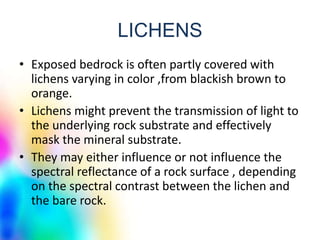Soil moisture
- 1. APPLICATION OF REMOTE SENSING IN SOIL STUDIES BY: SrutiSudha Mohanty 2014MSES018 Department Of Environment Science
- 2. SOIL : BASIS OF LIFE Soil is of major importance to mankind because if supports the plants & animals that provide us with food ,shelter & clothing. Different concepts of soils have been developed by agriculturists and engineers.
- 3. SOIL : Agriculturist perspective • Soil is a complex entity of minerals , water & air and influenced by living things. • To them , most of the soil profile is significant for plant growth; • the surface (A horizon) because it is the seat of biological activity & principal source of nutrients. • B horizon (subsoil) affects drainage, soil moisture retension, aeration & root development of plants • C horizon; because it may contain weatherable minerals yielding nutrients & its texture may affect permeability. • D horizon;the deeper part of soil is generally of less importance to plant growth.
- 4. SOIL:ENGINEER PERSPECTIVE • In engineer’s view ,soil merely in terms of unconsolidated sediments & deposits of solid particles derived from the disintegration of rock. • Soil comprised of 3 phased system in some state of dynamic equilibrium, i.e, Solid (particulate organic and inorganic material) Liquid (consisting of soil solution containing various salts) Gas (soil air)
- 5. Conventional Mapping of Soil • Russian scientist ,Dokuchaiev, first explained the relationship between soil profile & the environment. • Soil Series: A group of soils of similar profiles derived from a particular parent material • Soil phases: On the basis of any characteristic or combination of characteristics potentially significant to our use or management of soil • Attributes : Slope ,degree of erosion, depth of soil, stoniness ,salinity, physiographic position
- 6. Spatial Stratification of Landscape • A common way of spatially segmenting the landscape is to divide it into internally more or less homogeneous & mutually contrasting land form units • For classical soil mapping,such as the SOTER (Soil & Terrain) methodology,the classical maps can be used to draw soil boundaries.
- 7. Landform Mapping Traditionally,landform mapping is done by visually interpreting aerial photographs. It can be done by using digital sources like DEMs(digital elevation models) acquired by remote sensing. Typically,the surface is parameterized by attributes such as elevation,slope,profile curavture and flow accumulation to obtain surface topography units.
- 8. • 3 types of relief units are distinguished based on decreasing complexity. i. Firstly elementary forms (smallest and simplest geometric units) ii. Secondly, composite of elementary forms iii. Thirdly, association of landforms
- 9. Land form mapping based on combined data sources • The combination of DEM with spectral data can improve landform classification in complex landscapes. • Different landform models have been developed for using spectral data in combination with data from SRTM (Shuttle Radar Topography Mission) and Landsat Thematic Mapper.
- 10. Digital Elevation Model • The most widely used sources of DEM data are LIDAR (Light Detection Ranging) and SAR (Synthetic Aperture Radar). • Dependent on the sensor flight altitude , LIDAR allows highly accurate and very densely sampled elevation points.
- 11. Soil Parameters Using for Remote Sensing • Surface colour • Surface roughness • Soil temperature • Soil moisture • Vegetation pattern & indices • Mineralogy • Soil Organic Carbon • Iron content • Soil salinity • Lichens • Non photosynthetic vegetation
- 12. SURFACE COLOUR In remote sensing ,the surface colour affect the percentage of isolation received at the surface which is reflected back to space. Dry Sandy Soil, Albedo=37% Moist Black Soil, Albedo=8%
- 13. SURFACE ROUGHNESS • Created by cultivation or inherent soil structure • Observation through scattering of incident radiation
- 14. SOIL TEMPERTURE • It can be detected by thermal sensors. • Major factor affecting the temperature relation of the soil is its Specific heat/Thermal capacity. • Specific heat of soil: The amount of heat required to raise the temperature of a given substance from 15°C to 16°C compared with that required for the same rise in temperature of an equal weight of water. • In field condition , the soil moisture content determines its thermal capacity.
- 15. SOIL MOISTURE • Obtained from Microwave RADAR • Related with dielectric properties of water • Dielectric constant of soil depends on the water content of the soil • 2 methods are used to measure the soil water content. 1. Gravimetric method:- in terms of % of dry weight of the solids forming soil 2. Volumetric method:- in terms of % of volume of the soil • Recent RS study on soil properties is based upon the “available” water in the soil.
- 16. Vegetation Patterns and Indices Spatial & temporal variation indices have been found to be linked to prevailing climate,ecosystem,terrain and physical soil properties. The Normalized Difference Vegetation Index (NDVI) is one of the most common indicators of crop growth characteristics of specific site qualities. E.g, root zone soil moisture,soil colour,soil texture,water holding capacity,soil carbon and nitrogen content
- 17. Mineralogy • The analysis of mineralogy with spectral proximal sensing has made great progress over the last years. • With remote sensing , mineralogy can be determined from the spectral signature of rock outcrops or from the mineral composition of bare in-situ soils.
- 18. SOIL ORGANIC CARBON • Most research on the determination of soil organic carbon with remote sensing has been perform at plot scale(<1 km²). • When mapping SOC on a large scale without extensive calibration,a solution could be to use indices based on reflectance for quantifying soil organic carbon. • The amount of SOC is then detected with reflectance spectroscopy based on the constituents of SOC: cellulose,starch,lignin. • Good relations have been found for indices on the visible part of spectrum.
- 19. IRON CONTENT • Soil iron can be seen as an indicator of soil fertility and the age of sediments. • RS imagery has been used for determining the presence of iron over areas upto 500km². • Both soil color and absorption features have been used to derive iron content. • Iron oxides and Iron hydroxides have specific absorption features that are located in the VNIR (visible & near-infra red) & can be measured from multispectral spectrometer images.
- 20. SOIL SALINITY • In arid and semi-arid climates ,precipitaion is insufficient to maintain a regular percolation of rain water through the soil,so soluble salts accumulate. • Both RADAR and optical remote sensing data have been used for mapping soil salinity. • It is based on the dielectric properties of soil as salinity is a key element of the electric conductivity.
- 21. NON PHOTOSYNTHETIC VEGETATION • Non-photosynthetic vegetation(NPV) such as crop residues,woody stems and forest litter influences the spectral response of bare soil and thus the accuracy of determined soil properties. • In RS studies, The imaging spectrometer Cellulose Absorption Index (CAI) and multispectral Lignin- Cellulose Absorption (LCA) index are used to estimate Crop residue cover.
- 22. LICHENS • Exposed bedrock is often partly covered with lichens varying in color ,from blackish brown to orange. • Lichens might prevent the transmission of light to the underlying rock substrate and effectively mask the mineral substrate. • They may either influence or not influence the spectral reflectance of a rock surface , depending on the spectral contrast between the lichen and the bare rock.
- 23. SOIL PROXIES • The efficiency of using remote sensing to map soil properties in densely vegetated areas depends on indirect relations between vegetation and soil attributes. • To retrieve soil properties ,more detailed information on the vegetation cover is needed. • Two useful proxy indicators have been used to retreive soil properties from RS data: Plant Functional Types (PFT) & Ellenberg indicator values. • PFT may be derived from high resolution imaging spectrometer data on a plot level.
- 24. Applications For survey of : soil erosion vegetation agriculture irrigation forestry drainage Soil classification
- 25. Development of satellite remote sensing on soil studies • Before the launch of Landsat 1, aerial photographs were being used for soil mapping. • In mid 80’s , high resolution Landsat TM & IRS LISS 2 data enabled soil scientist to map soils at 1:50,000 scale (district level).
- 26. Spectral behaviour of soil • Spectral response pattern is generally governed by numbers of factors ,i.e, different soil properties. • Chemical composition of soil influences spectral signature of soils through the absorption process.
- 27. Need & Scale of Soil Mapping • Small scale maps of 1:1million = macro level planning i.e, national level • 1:250,000 scale = regional or state level for several agricultural uses • 1:50,000 scale= district level for planning resource conservation & optimum land use • 1:8000 /1:4000 scale = for specific purposes (jhum lands, water logged areas)
- 28. Example • In one of the major projects in Department of space,Government of India – “integrated Mission for Sustainable Development “ ,the soil mapping has been taken up at 1:50,000 scale for about 175 districts in the country.
- 29. Soil Mapping Methods • Aerial photographs provide info about physiographic variations • Methodology involves : a. Visual interpretation based on size ,shape etc comprises of 3 tier approach i.e, interpretation of remote sensing imagery/aerial photograph,field survey & cartography b. Computer aided approach





























